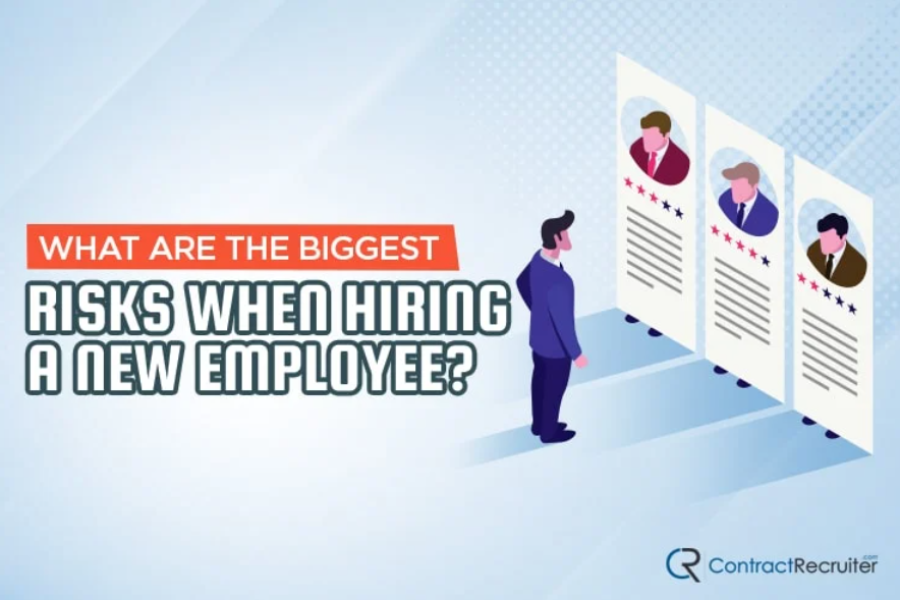Hiring a new employee will always be a risk; it’s a cluster of risks. Some of them are calculated risks with a high reward. Some of them are standard risks inherent in doing business. Others are risks that can be mitigated, so long as you know what they are. What risks are the biggest, though?
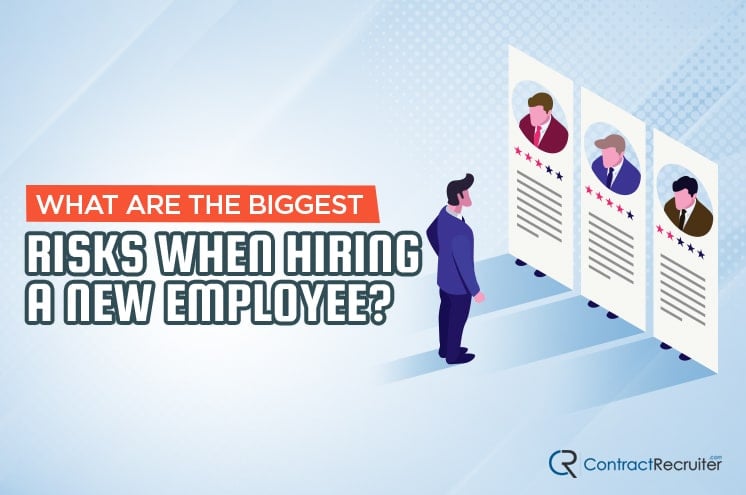

Risk: Hiring the Wrong Person
This first set of risks is one of the biggest and most apparent risks a company faces when hiring a new employee. What happens if you hire the wrong person for the job? There are many reasons why this might occur, which is why probationary periods, contingent offers, training programs, and other aspects of onboarding exist.


Hiring the wrong person can be bad, or it can be devastating. A poor choice in an employee can still work out with proper investment, though it will be more expensive and time-consuming than it would have been had you hired the right person in the first place. On the other hand, sometimes the people you hire are entirely incompatible with your company. In these cases, it’s money and time lost, and you need to recognize when to cut your losses and start over.
Risking a poor culture fit.
Have you ever hired someone, only to find they just don’t fit in? We don’t mean hiring an introvert in a company full of extroverts; we mean hiring someone whose ideas, perspectives, and goals are fundamentally incompatible with those of your company. Think “hiring a militant vegan to work at a dairy farm” levels of incompatibility here. Drama builds, tensions rise, morale falls, productivity suffers, and sooner or later, something will break.
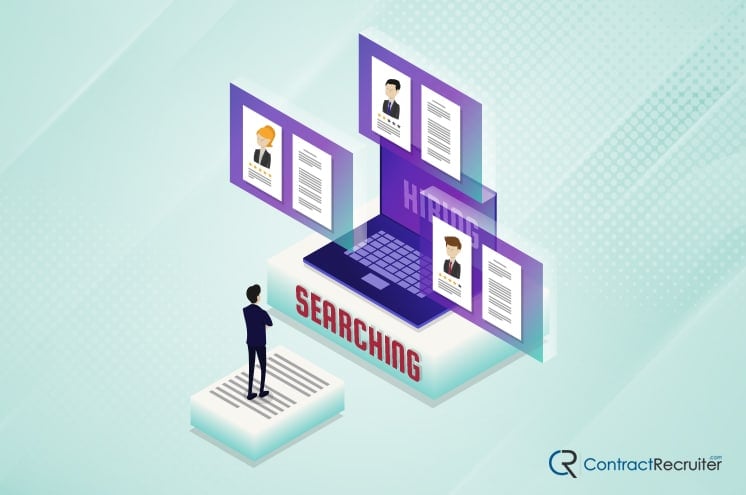

“When employees are misaligned with corporate culture, they lack a feeling of belonging that can severely impact their performance and lead to disengagement or employee turnover. When good employees leave, it can be as simple as not feeling in tune with company values, feeling unaligned with the company’s meaning and purpose, or lack of trust in company leadership. But it can also be a profound disconnect and feeling of isolation and loneliness. Widespread issues with alignment can cripple your top performers and even help create a toxic environment across the organization.” – Predictive Index.
Risking an under-skilled or under-trained employee.
It’s no secret that people exaggerate their resumes to look more attractive to applicant tracking systems and to hiring managers. Sometimes it’s as minor as exaggerating expertise in a skill, and sometimes it means fabricating a skill out of whole cloth.
Sometimes, this can get solved by training your employee to fit the role you’ve hired them to handle. A good employee with the right attitude can get trained in the skills you need; an employee with the skills may not be trainable to gain the right attitude.
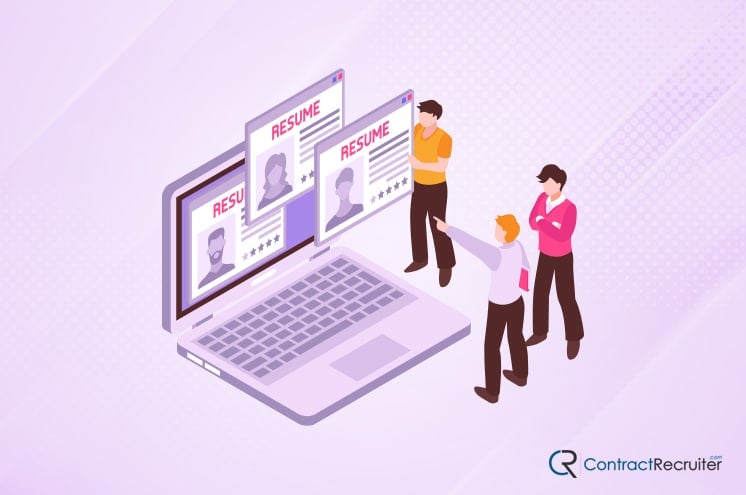

In other cases, the exaggeration is more egregious and shows a compulsive lying or misrepresentation pattern. These people can be highly toxic in the workplace, and it’s best to rid yourself of them before they cause worse problems for the rest of your staff.
Risking falling for fake credentials.
Most people who lie or exaggerate on their resumes and applications do so in minor ways. Perhaps they claim they held a slightly higher position than they did. Maybe they say they have four years of experience in a skill when they only have three. While unfortunate, these aren’t liable to cause a significant problem.


Other times, lies can approach fraud territory. Lying about achieving a higher education degree, lying about certification; these are the sorts of verifiable facts that some people lie about despite how easy it may be to be caught, simply because many companies don’t bother to check. Double-check and verify your applicants’ claims to avoid hiring someone wildly inappropriate for the job.
Risk: Improper Hiring Practices


Hiring the wrong person is the biggest risk because it’s the most common, but it’s relatively minimal on the scale of business risks. Sure, turnover is expensive, but it’s not business-crushingly devastating. On the other hand, improper hiring practices can be highly detrimental to a business, especially if an overlooked applicant, rejected candidate, or ex-employee files a lawsuit over discriminatory hiring practices. These kinds of cases can consume vast amounts of time and money, and in the worst cases, can lead to court sanctions, huge fines and penalties, and payments to those aggrieved. For obvious reasons, these become huge risks.
Risking asking illegal interview questions.
As a general rule, interviews should stick to facts relevant to skills, work experience, past positions, and aspects of an individual relevant to the job itself.


Anything that is related to or could be considered related to a protected class is something that can get your business in a lot of hot water.
“At first glance, this seems easy enough. But even some questions we treat as small talk can be viewed as discriminatory and can end up serving as evidence against you in an employment practices suit. All it takes is one disgruntled applicant to turn a seemingly innocent question into something you didn’t intend for it to be.” – HNI.
Questions about where a candidate grew up, their family, and holidays they celebrate; can seem like small talk but can get construed as asking about nationality, family status, or religious affiliation in a way that can be considered discriminatory.
Risking inconsistency across interviews.
One of the keys to avoiding discriminatory hiring practices is to ensure that every interview follows the same template from start to finish. The entire hiring process, from processing resumes to final interviews, should be consistent from candidate to candidate.


No matter how minor, any difference can be considered favoritism or discrimination if it can be tied back to a protected category. Even something like whether or not you perform a background check is essential.
Risking adverse impact or discrimination in hiring.
Adverse impact is tricky. It’s discrimination that happens despite practices that appear equitable.
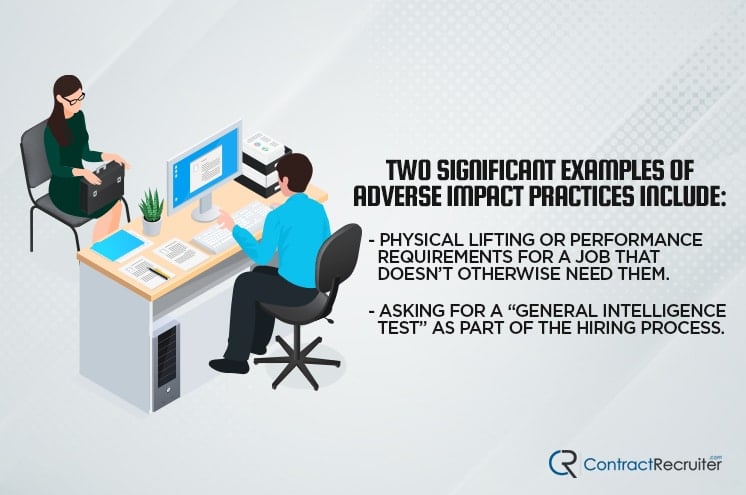

Two significant examples of adverse impact practices include:
- Physical lifting or performance requirements for a job that doesn’t otherwise need them. A data entry clerk doesn’t need to have the ability to lift 50 pounds daily the way a construction worker might, so listing that requirement has a disproportionate adverse impact against the physically disabled.
- Asking for a “general intelligence test” as part of the hiring process. These tests are frequently couched in the local culture and rely on cultural trivia, which can be a form of cultural, national, or ethnic discrimination.
In our post about the subject, you can read more about adverse impact, including methods you can use to avoid it in your hiring practices.
Risk: New Employees Leave
Closely related to the first set of risks is the one risk every employer must take on every employee: the risk that they will potentially leave shortly after being hired.
The hiring process is costly, in both time and money. You have to pay for an ATS, pay for the time of the people managing hiring, and potentially even pay for a candidate’s travel, lodging, and transportation during the interview process. All of this is money and time lost if the employee changes their mind about working for you late in the process or within the first year after being hired.


Some turnover is inevitable. However, a big part of successful hiring is finding the people who will best fit in and minimizing the risk of an employee leaving shortly after they arrive.
Risking the financial investment of hiring.
Again, some turnover is inevitable. Every candidate you interview is a financial risk. As compiled by Toggl:
“As stated in a study by the National Association of Colleges and Employers, hiring an employee in a company with 0-500 people costs an average of $7,645.
Another study by the Society for Human Resource Management states that the average cost to hire an employee is $4,129, with around 42 days to fill a position.
According to Glassdoor, the average company in the United States spends about $4,000 to hire a new employee, taking up to 52 days to fill a position.”
These costs don’t include the expense of initial training and salary that a failed hire still deserves, even if they choose to leave.


Some costs can be minimized. Some reasons for an employee leaving can be minimized as well, such as by paying attention to culture fit. Others, like family emergencies, medical issues, and other problems outside of the control of you or the employee, are just the cost of doing business.
Risking the ongoing training and investment in an employee.
Every dollar you invest in your new hires is a dollar you risk losing if they leave.
However, this doesn’t mean you should avoid investing in your employees. Quite the contrary; if you don’t invest in your employees, they are more likely to leave. This mindset is where many companies get it wrong; they feel like training an employee makes that employee more attractive to poaching from other companies.


While this is true, to an extent, it can be fought by providing established routes to career advancement within the organization. If they feel secure and have a future with your company, your employees will be less likely to leave for uncertain pastures. It’s only if they stagnate despite their training that they start looking elsewhere.
Risking over-hiring for a job or role.
Another significant risk a company takes when hiring for a role is hiring someone who is over-qualified. To a certain extent, hiring a professional for a mid-level role (or a mid-level employee for an entry-level position) seems like a good idea. They know what they’re doing and can hit the ground running.
The trouble comes when they soon reach the limit of their position. Someone used to tier-2 IT work might chafe at working a help desk, for example.
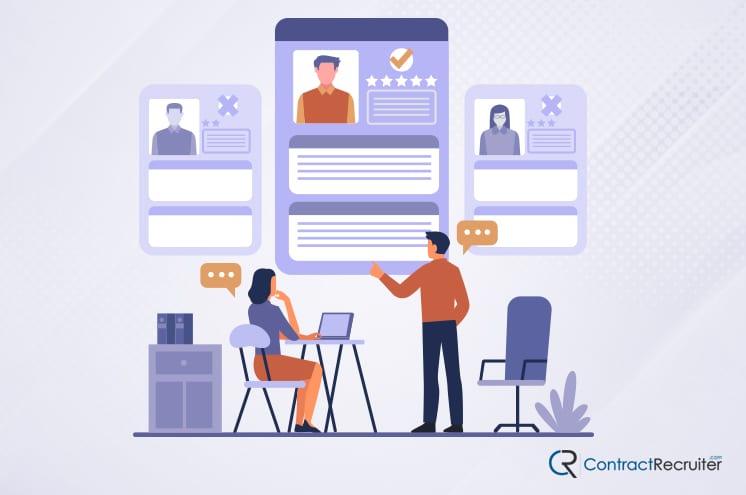

This situation becomes a risk in two ways. First, the employee is more likely to be more expensive to hire, as their skill level commands a higher salary. Second, when they reach the limits of the role and discover how little they can spread their wings, they’re more likely to leave, forcing you to start over once again.
Other Assorted Risks
These remaining risks are more difficult to categorize but no less important for a business to consider.
Risking hiring people to hire people, diluting goals and culture.
This risk tends to come in companies expanding rapidly and hiring in volume. When the people doing your hiring are people you hired recently, they lack a distinct connection and deep awareness of your company cultures, values, and outlook.


They hire according to what they think those are, but after a couple of iterations, the reality can be quite different from your original goals and perspectives.
Risking a critical lack of diversity in the workforce.
Diversity of individuals and mindsets is critical for a modern business to succeed.


You can read more about this in these articles:
- 25 Diversity and Inclusion Statistics You Should Know
- Thought Diversity: What Is It and Why Is It Important for Recruiting?
- What are the Characteristics of an Effective and Successful Team?
Risking hiring someone who ends up unable to work in your location.
This last risk for this post is relevant primarily for companies that hire remote or foreign workers. For an individual of foreign origin to work in the country, they, typically, must obtain permission via a Work Visa and related paperwork.


That brings additional risk to companies looking to hire these individuals; if their paperwork is not correctly handled, they fail a background check, or otherwise are not cleared to work in the country, hiring them can become an issue.

